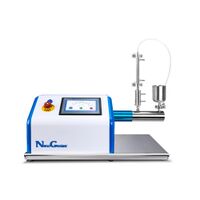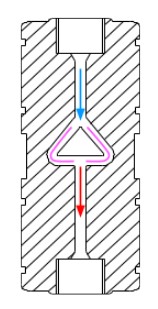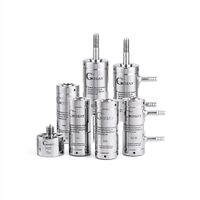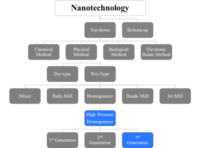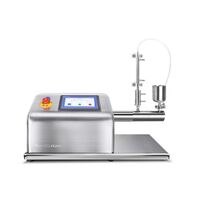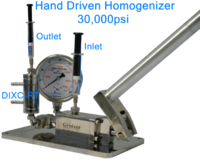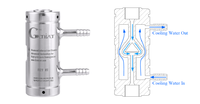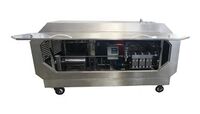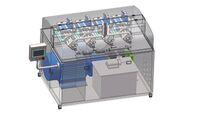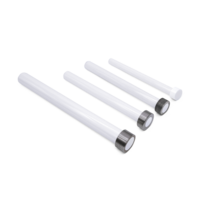Difference between revisions of "High Pressure Homogenizers"
| Line 86: | Line 86: | ||
==Selecting homogenization parts== | |||
[[File:High_Pressure_Homogenizers_Homogenization_chamber_performance_comparison.jpg|thumb|200px|right|Homogenization chamber performance comparison]] | |||
As a core component of homogenizers, homogenization chambers play a decisive role in achieving optimum results for the process. Different inner constructions of homogenization chambers lead to different results and applications. | |||
When selecting a suitable homogenizer, the purchaser must consider both performance and cost. In general, the cost of the first-generation homogenization chamber is more economical, but its performance in the homogenization process is not as good as the second generation’s. The second-generation homogenization chamber produces a superior product, but when processing materials with high concentration and viscosity, it is more likely to block than first-generation machines, and its cost is higher as well. The interaction chamber with a cooling system, developed by Genizer, can be used for thermally unstable biological and pharmaceutical products. | |||
==Maximum homogenizing pressure== | |||
In general, higher homogenizing pressure leads to better quality. This is because the particle size will be much smaller and more uniform if the homogenizer’s pressure is higher, which means processors produce the nanomaterial more efficiently. Higher homogenizing pressure also allows more kinds of samples to be processed. For example, emulsions usually require a homogenizing pressure of 20,000 psi to achieve a particle size of 100 nm, while suspensions usually require at least 45,000 psi to reach nanoscale. | |||
It should also be noted that high temperature will affect the results of the homogenization process. The higher the pressure is, the higher the temperature will be. Because of this, 30,000 psi is the maximum pressure for high pressure homogenization without a cooling system. Due to the high temperature, the homogenization effect of more than 30,000 psi does not increase with pressure. The development of the ultra-high pressure diamond interaction chamber with a cooling system can effectively reduce the content of large particles and solve the problem of emulsion stability caused by high temperature. Therefore, machines equipped with this type of chamber can achieve pressures up to 60,000 psi. | |||
==Product uniformity== | |||
Generating a uniform particle size distribution is quite important during the production process. A wide distribution of particle size from nanometer to micron not an acceptable result, especially if particles larger than 5 um are present in a pharmaceutical emulsion. USP (US Pharmacopeia) regulates the particle size distribution of pharmaceutical emulsions. Interaction chambers produce a more uniform particle size distribution than impact valve homogenizers. | |||
=Video= | |||
<youtube>hcFtEDkFDAM</youtube> | <youtube>hcFtEDkFDAM</youtube> | ||
Revision as of 05:58, 25 February 2022
High Pressure Homogenizers are used for homogenization of compounds that require high pressure for the processes. High Pressure Homogenizers are often the solution particularly useful in the pharmaceutical and biotech industries. High pressure homogenizers, prepare nanomaterial by producing high flow velocity through a small orifice, using a specially designed internal fixed geometry under ultra-high pressure (up to 60,000 psi). During the homogenization process, changes in physical, chemical, structural properties occur, and as a result, homogeneous suspension takes place at nanoscale. The pressure of a conventional homogenizer is within 15,000 psi, while a high pressure homogenizer can achieve 30,000 psi, and an ultra-high pressure homogenizer can reach up to 60,000 psi.
Introduction
High pressure homogenizers are used in the biological, pharmaceutical, food, chemical, and many other industries. Their products and purposes include cell disruption, food homogenization, fine chemicals, preparation of liposomes, fat emulsions, nanosuspensions, microemulsions, lipid microspheres, vaccines, emulsions, dairy products, infusion solutions, dyes, graphene, carbon nanotubes, conductive coatings, nano-oxide dispersion, and more. The global market for high pressure homogenizers is growing annually, and this is especially true in the nanotechnology market. To prepare pharmaceutical nanoemulsions, high pressure homogenizers such as the nanogenizer are essential: Their pressure is always above 20,000 psi, and they feature high-quality diamond interaction chambers to achieve a uniform, pharmaceutical-grade nanoparticle size distribution.
Key Principles
The key component of a high pressure homogenizer includes a homogenization unit such as diamond interaction chamber, and a high pressure pump unit. There is a specially designed fixed geometry inside the diamond interaction chamber. Strokes of the piston in the high pressure pump unit drive the samples through the interaction chamber at supersonic speed. In the chamber, materials are subjected to mechanical forces such as high shearing, high-frequency oscillation, cavitation and convective impact, and corresponding thermal effects simultaneously. These mechanical and physiochemical effects can induce change in the physical, chemical, and particle structure of the materials. This results in uniform and smaller nanoparticle size, achieving a homogenization effect. The interaction chamber is the core of the high pressure homogenizer, and its unique geometric internal structure is the main factor determining the effectiveness of the homogenization process. The intensifier pump exerts the required pressure for materials to pass through the interaction chamber at high speed. The pressure’s strength and stability are important to ensure the production of high-quality nanomaterials.
Applications
The high pressure homogenizer is one of the most effective pieces of equipment for preparing nanomaterial using top-down nanotechnology. The high pressure homogenizer and its interaction chamber have a wide variety of applications in the production of nanomaterial and nanotechnology.
These applications include:
- Preparation of fat emulsion, microemulsions, liposomes, nanosuspensions, and nanoparticles in the pharmaceutical industry;
- Cell disruption, microcapsules, and vaccine adjuvants in biotechnology products;
- Homogenization and emulsification in the food and beverage industry to improve stability, taste, appearance, and encapsulation of nutrients in food products;
- Homogeneous dispersion of products in the cosmetics, fine chemical, and other industries to improve product functionality, increase value, and ensure process stability;
- Dispersion and exfoliation of conductive paste, resistance paste, graphene, carbon nanotubes, and nano-oxides.
Classification
By energy source
Electric
Electric homogenizers are powered by an electric motor. This category of homogenizer can be further subdivided into two types: direct-drive and intensifier.
Direct-drive type
The motor drives the crankshaft to move the plunger back and forth, directly pressurizing the material. Multiple plungers in the crankshaft work together to produce constant pressure and a high flow rate; large quantities of materials are required to produce the constant pressure. To drive the crankshaft, the motor requires a multi-stage gear reduction mechanism, which makes the equipment large in size. The homogenizer with a crankshaft is suitable for large-scale production with low-pressure applications.
Intensifier type
In intensifier-type high pressure homogenizers, the motor drives the intensifier to pressurize the material through the interaction chamber. The intensifier system can provide higher pressure, thereby improving the performance of the homogenization process. The flow rate of the homogenizer with an intensifier is lower than it is for the homogenizer with a crankshaft, smaller amounts of materials are required, and the pressure is higher. It can be used for laboratory applications with small amounts sample, and for production applications with high pressure. When equipped with the diamond interaction chamber, the electric high pressure homogenizer with an intensifier falls into the category of high-end homogenizers. This type is widely used in biology, pharmaceutical, and nanotechnology laboratories. The traditional intensifier is hydraulic, and the new type of electric cylinder by linear actuator is emerged with more performance.
Hand Driven
Hand driven homogenizers pressurize the material by manual power. The flow rate of a hand homogenizer is small, but it is portable and easy to assemble and disassemble. It requires very small amounts of materials, making it suitable for small-scale experiments. This type of device is capable of supporting biopharmaceutical laboratories’ research and development needs. The manual high-pressure homogenizer is also called the Handgenizer.1
Air Driven
The air driven homogenizer converts the pressure of compressed gas into hydraulic pressure. Therefore, it needs the support of a nitrogen cylinder or an air compressor. This homogenizer’s gas consumption and noise levels are high, and its maximum homogenization pressure is generally low. However, since there is no separate intensifier pump structure, its volume is small, and it is suitable for sites equipped with compressed nitrogen.
By principle and structure of the interaction chamber
First Generation: Impact Type
Cavitation nozzles: The main function of this nozzle is cavitation, which leads to the separation of the emulsion and thereby increases the particle size. Under the pressure of the homogenizer, the materials flow into the cavitation nozzle with a very small aperture at several times the speed of sound. Meanwhile, intense friction and collision take place between the particles and the metal valve parts. This friction reduces the service life of the equipment, and the collisions cause metallic particles to fall into the final products.
Impact valve: The impact valve and impact ring structure moderately reduce local wear and prolong the homogenization chamber’s service life by using tungsten alloy materials. The role of the impact valve is a combination of impact and cavitation. However, its basic principle is the collision of the material in the suspension with the structure of a high-hardness metal (such as tungsten alloy). Therefore, the impact valve still cannot solve the problem of metallic particle residue. By the first decade of the 20th century, most high pressure homogenizers have added impact valve component.
Second Generation: Interaction Type
Y-type interaction chamber: The Y-type interaction chamber, regarded as one of the most powerful homogenization chambers to date, has been used by several manufacturers in the USA. In these systems, the flow stream is split into two channels that are redirected over the same plane at right angles and propelled into a single flow stream. High pressure promotes a high speed at the crossover of the two flows, which results in high shear, turbulence, and cavitation over the single outbound flow stream. With the unique Y-type structure, the high-speed moving materials in the high-pressure solution collide with each other, in a process that greatly improves the service life of the chamber over those with more conventional designs. The use of diamond material prevents the formation of metal particle residue.
The Y-type interaction chamber is widely used in the preparation of pharmaceutical emulsions because it minimizes cavitation and produces exquisite, stable particle size and PDI (poly dispersity index) control ability. Genizer and Microfluidics Corp. are the main manufacturers of the diamond interaction chamber. At present, the Y-type diamond interaction chamber is mainly used in high-end nanotechnology, and it occupies more than 90% of the US pharmaceutical industry. Genizer’s temperature-controlled interaction chamber avoids temperature surges and enables working pressure of up to 60,000 psi.
Low emulsification efficiency and metallic particle residue are two problems caused by homogenization chambers designed with the impact principle. When particles collide with internal metal components during the production of pharmaceutical injections, residual inert metallic particles generate. These metallic particles may gather and form larger particles. In pharmaceutical applications, this is a problem because large particles will lead to a decrease in capillary blood flow, which in turn will cause mechanical damage to tissues in the human body, causing acute or chronic inflammation. The interaction chamber solves the problems of particle residue and demulsification. However, the chamber’s internal structure means that when the products’ concentration and viscosity are high, the chamber is more prone to cause flow blocking than impact homogenizers are.
By principle of pressurization
The ultra-high pressure homogenizer needs a large thrust to push the piston in the cylinder to achieve high pressure levels. The rotating motor needs to reduce the speed, increase the torque, and convert the linear motion to obtain the linear reciprocating motion with high thrust. The principle of pressurization operates differently in direct-drive type and intensifier-type homogenizers.
Direct-drive type
The motor drives the crankshaft to move the plunger back and forth and directly pressurize the material. Multiple sets of plungers provide constant pressure, and the flow rate is high for this type of homogenizer. However, the minimum material requirements are also high, as is the amount of residual produced. The crankshaft driven by the motor needs a multi-stage gear reduction mechanism, which limits these homogenizers to only moderate efficiency and requires large unit dimensions. This homogenizer type is suitable for the food and chemical industries, as well as other applications that do not have high pressure requirements.
Intensifier type
The intensifier-type homogenizer is the result of the development of ultra-high pressure technology in recent years. One of its mechanisms involves the motor driving the oil pump to pressurize the material through the hydraulic system. The pressure provided by the hydraulic system is higher than in direct-drive homogenizers, while the volume and the minimum material requirement is smaller. The intensifier-type homogenizer can be applied to both laboratory and production homogenizers with high pressure. Hydraulic homogenizers are expensive, but the hydraulic intensifier can achieve low-frequency and high-thrust piston movement, which increases the machine’s service life and reduces its maintenance costs. Using parallel four-cylinder technology, stable pressure can be obtained without an accumulator, achieving ultra-high pressure of up to 45,000 psi.
In the past, most high pressure homogenizers were the direct-drive type, but this type’s disadvantage is obvious. Its service life is short, and its wearing parts need frequent maintenance, especially those pressure-bearing parts when the pressure is above 100 MPa. Hydraulic homogenizers have a high manufacturing cost, but they also offer a long service life and lower maintenance costs for wearing parts.
How to select a high pressure homogenizer
Selecting a high pressure generator
Overall, a cylinder with an intensifier is superior to a direct-drive one. Under the same flow rate, higher pressure produces lower frequency, fewer pressure fluctuations, better product quality, and greater equipment durability. At 30,000 psi, a laboratory high pressure homogenizer, can reach fluctuation levels of less than 10 Hz, as opposed to 60 Hz from a normal homogenizer. High pressure piston materials can be divided into ceramics, tungsten carbide, and hardened stainless steel, with ceramics as the costliest option and hardened stainless steel as the most affordable. Quality and durability align with cost: Ceramic materials offer the highest quality, followed by hard tungsten alloy, with hardened stainless steel as a lower-quality option.
Selecting homogenization parts
As a core component of homogenizers, homogenization chambers play a decisive role in achieving optimum results for the process. Different inner constructions of homogenization chambers lead to different results and applications. When selecting a suitable homogenizer, the purchaser must consider both performance and cost. In general, the cost of the first-generation homogenization chamber is more economical, but its performance in the homogenization process is not as good as the second generation’s. The second-generation homogenization chamber produces a superior product, but when processing materials with high concentration and viscosity, it is more likely to block than first-generation machines, and its cost is higher as well. The interaction chamber with a cooling system, developed by Genizer, can be used for thermally unstable biological and pharmaceutical products.
Maximum homogenizing pressure
In general, higher homogenizing pressure leads to better quality. This is because the particle size will be much smaller and more uniform if the homogenizer’s pressure is higher, which means processors produce the nanomaterial more efficiently. Higher homogenizing pressure also allows more kinds of samples to be processed. For example, emulsions usually require a homogenizing pressure of 20,000 psi to achieve a particle size of 100 nm, while suspensions usually require at least 45,000 psi to reach nanoscale. It should also be noted that high temperature will affect the results of the homogenization process. The higher the pressure is, the higher the temperature will be. Because of this, 30,000 psi is the maximum pressure for high pressure homogenization without a cooling system. Due to the high temperature, the homogenization effect of more than 30,000 psi does not increase with pressure. The development of the ultra-high pressure diamond interaction chamber with a cooling system can effectively reduce the content of large particles and solve the problem of emulsion stability caused by high temperature. Therefore, machines equipped with this type of chamber can achieve pressures up to 60,000 psi.
Product uniformity
Generating a uniform particle size distribution is quite important during the production process. A wide distribution of particle size from nanometer to micron not an acceptable result, especially if particles larger than 5 um are present in a pharmaceutical emulsion. USP (US Pharmacopeia) regulates the particle size distribution of pharmaceutical emulsions. Interaction chambers produce a more uniform particle size distribution than impact valve homogenizers.
Video

